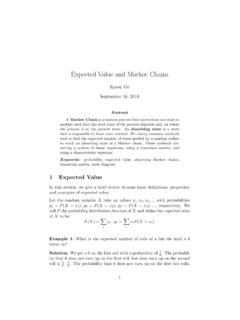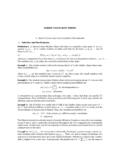Transcription of Key words. AMS subject classifications.
1 THE FIVE GREATEST APPLICATIONSOFMARKOV CHAINSPHILIPP VON HILGERS ANDAMY N. LANGVILLE hundred years removed from A. A. markov s development ofhis chains, we takestock of the field he generated and the mathematical impression he left. As a tribute to markov , wepresent what we consider to be the five greatest applicationsof markov chains, markov applications, stationary vector, PageRank, HIdden Markovmodels, performance evaluation, Eugene Onegin, information theoryAMS subject , 60J20, 60J22, 60J27, 65C401. five applications that we have selected are presented inthe boring but traditional chronological order. Of course,we agree that this orderingscheme is a bit unfair and problematic.
2 Because it appears first chronologically, is markov s application of his chains to the poem Eugeny Onegin the most impor-tant or the least important of our five applications? Is A. L. Scherr s application ofMarkov chains (1965) to the performance of computer systemsinferior to Brin andPage s application to web search (1998)? For the moment, we postpone such difficultquestions. Our five applications, presented in Sections 2-6, appear in the admittedlyunjust chronological order. In Section 7, we right the wrongs of this imposed orderingand unveil our proper ordering, ranking the applications from least important to mostimportant. We conclude with an explanation of this ordering.
3 We hope you enjoythis work, and further, hope this work is discussed, debated, and A. A. markov s Application to Eugeny list claiming tocontain the five greatest applications of markov chains mustbegin with Andrei s own application of his chains to Alexander S. Pushkin s poem Eugeny One-gin. In 1913, for the 200th anniversary of Jakob Bernoulli s publication [4], Markovhad the third edition of his textbook [19] published. This edition included his 1907paper, [20], supplemented by the materials from his 1913 paper [21]. In that editionhe writes, Let us finish the article and the whole book with a good example of de-pendent trials, which approximately can be regarded as a simple chain .
4 In what hasnow become the famous first application of markov chains, A. A. markov , studied thesequence of 20,000 letters in A. S. Pushkin s poem Eugeny Onegin, discovering thatthe stationary vowel probability isp= , that the probability of a vowel followinga vowel isp1= , and that the probability of a vowel following a consonant isp2= In the same article, markov also gave the results of his other tests; hestudied the sequence of 100,000 letters in S. T. Aksakov s novel The Childhood ofBagrov, the Grandson. For that novel, the probabilities werep= ,p1= ,andp2= first glance, markov s results seem to be very specific, butat the same timehis application was a novelty of great ingenuity in very general sense.
5 Until that time,the theory of probability ignored temporal aspects relatedto random events. Math-ematically speaking, no difference was made between the following two events: a die Max Planck Institute for History of Science, Berlin, Germany Department of Mathematics, College of Charleston, Charleston, SC 29424, VON HILGERS AND AMY N. LANGVILLEFig. background: The first 800 letters of 20,000 total letters compiled by Markovand taken from the first one and a half chapters of Pushkin s poem Eugeny Onegin. Markovomitted spaces and punctuation characters as he compiled the cyrillic letters from the poem. Rightforeground: markov s count of vowels in the first matrix of 40total matrices of10 10letters.
6 Thelast row of the6 6matrix of numbers can be used to show the fraction of vowels appearing in asequence of 500 letters. Each column of the matrix gives moreinformation. Specifically, it showshow the sums of counted vowels are composed by smaller units of counted vowels. markov arguedthat if the vowels are counted in this way, then their number proved to be stochastically FIVE GREATEST APPLICATIONS OF markov CHAINS157thrown a thousand times versus a thousand dice thrown once each. Even dependentrandom events do not necessarily imply a temporal aspect. Incontrast, a temporalaspect is fundamental in markov s chains. markov s noveltywas the notion that arandom event can depend only on the most recent past.
7 When markov applied hismodel to Pushkin s poem, he compared the probability of different distributions ofletters taken from the book with probabilities of sequencesof vowels and consonantsin term of his chains. The latter models a stochastic processof reading or writingwhile the former is simply a calculation of the statistical properties of a distributionof letters. Figure shows markov s original notes in computing the probabilitiesneeded for his Pushkin chain . In doing so, markov demonstrated to other scholarsa method of accounting for time dependencies. This method was later applied tothe diffusion of gas molecules, Mendel s genetic experiments, and the random walkbehavior of certain first response to markov s early application was issued by a colleague atthe Academy of Sciences in St.
8 Petersburg, the philologist and historian NikolaiA. Morozov. Morozov enthusiastically credited markov s method as a new weaponfor the analysis of ancient scripts [24]. To demonstrate his claim Morozov himselfprovided some statistics that could help identify the styleof some authors. In histypical demanding, exacting, and critical style [3], markov found few of Morozov sexperiments to be convincing. markov , however, did mentionthat a more advancedmodel and an extended set of data might be more successful at identifying an authorsolely by mathematical analysis of his writings [22].3. C. E. Shannon s Application to Information Claude introduced A Mathematical Theory of Communication [30] in 1948, hisintention was to present a general framework for communication based on the prin-ciples of the new digital media.
9 Shannon s information theory gives mathematicallyformulated answers to questions such as how analog signals could be transformedinto digital ones, how digital signals then could be coded insuch way that noise andinterference would not do harm to the original message represented by such signals,and how an optimal utilization of a given bandwidth of a communication channelcould be ensured. A famousentropyformula associated with Shannon s informationtheory isH= (p1log2p1+p2log2p2+..+pnlog2pn), whereHis the amount ofinformation andpiis probability of occurrence of the states in question. Thisformulais the entropy of a source of discrete events. In Shannon s words this formula givesvalues ranging from zero when one of the two events is certain to occur ( , prob-ability 1) and all others are certain not to occur ( , probability 0) to a maximumvalue of log2 Nwhen all events are equally probable ( , probability1N).
10 These sit-uations correspond intuitively to the minimum informationproduced by a particularevent (when it is already certain what will occur) and the greatest information or thegreatest prior uncertainty of the event [31].It is evident that if something is known about a message beforehand, then thereceiver in a communication system should somehow be able totake advantage ofthis fact. Shannon suggested that any source transmitting data is a markov assumption leads to the idea of determining a priori thetransition probabilitiesof communication symbols, , the probability of a symbolfollowing another symbolor group of symbols. If, for example, the information sourceconsists of words of theEnglish language and excludes acronyms, then the transition probability of the letter u following the letter q is applied markov s mathematical model in a manner similar to markov s158 PHILIPP VON HILGERS AND AMY N.









